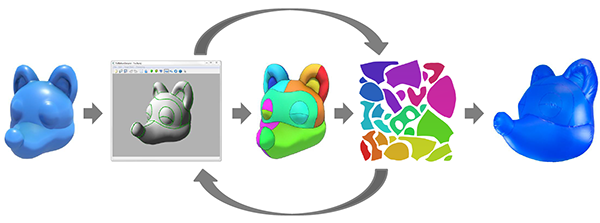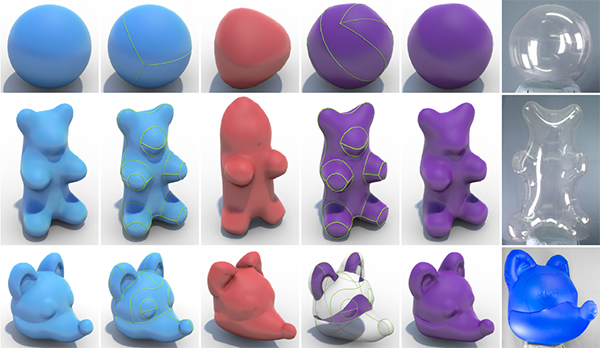Designing Inflatable Structures
M. Skouras, B. Thomaszewski, P. Kaufmann, A. Garg, B. Bickel, E. Grinspun, M. GrossProceedings of ACM SIGGRAPH (Vancouver, Canada, August 10-14, 2014), ACM Transactions on Graphics, vol. 34, no. 4, pp. 63:1--63:10
Abstract
We propose an interactive, optimization-in-the-loop tool for designing inflatable structures. Given a target shape, the user draws a network of seams defining desired segment boundaries in 3D. Our method computes optimally-shaped flat panels for the segments, such that the inflated structure is as close as possible to the target while satisfying the desired seam positions. Our approach is underpinned by physics-based pattern optimization, accurate coarse-scale simulation using tension field theory, and a specialized constraint-optimization method. Our system is fast enough to warrant interactive exploration of different seam layouts, including internal connections, and their effects on the inflated shape. We demonstrate the resulting design process on a varied set of simulation examples, some of which we have fabricated, demonstrating excellent agreement with the design intent.Overview
Inflatables are structures made of flat membrane elements that assume complex curved shapes when pressurized. Thanks to their lightweight nature, rapid deployment, and cost efficiency, they enjoy widespread popularity in entertainment, advertisement, engineering, and architecture. Designing inflatable structures requires solving a complicated patterning problem: what is the shape of the flat panels that we must cut, and how must we interconnect the panels, such that the final assembly inflates to the desired curved shape? This task is extremely challenging since the designer must anticipate, and invert, the effects of pressure on the shape of the structure, while simultaneously taking into account the aesthetics of seams. The combination of functional and aesthetic requirements make patterning the most difficult aspect of current manual design processes. We propose a computational approach for the interactive design of inflatable structures. We assume that the designer already has a certain target shape at hand, perhaps acquired from real world data, designed via modeling software, or provided as a specification by a client. Our goal is to help the designer to make plans for an inflatable structure that corresponds to the given target. In order to ensure that the designer retains full control over aesthetic considerations we lay aside fully automated approaches in favor of an interactive, optimization-in-the-loop methodology. As the designer sketches the proposed placement of seams, the underlying optimizer alleviates the iterative and errorprone tasks of reverse-engineering the physics of inflation, proposing a set of panels that best accommodate the desired seams and target shape.
Results
We used our design system to create a diverse set of inflatable structures. For validation, we also created physical prototypes for three of these examples. The fabricated models are made out of PVC plastic sheets. The optimized patches generated by our system were cut with a computercontrolled cutting machine and then manually hot-sealed.




